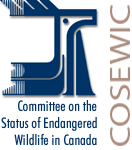|
|
|
|
|

|

News Release
Port Rowan, Ontario, May 7, 2004 In the heart of Canada's biologically diverse Carolinian zone, home to over a hundred species at risk, the Committee on the Status of Endangered Wildlife in Canada (COSEWIC) met to assess the conservation status of 36 wildlife species. One of the Carolinian species considered was the Round Pigtoe. This freshwater mussel that is now found only in Lake St.Clair, and three other Southwestern Ontario watersheds, is endangered by the exotic invasive Zebra Mussel, and by deteriorating water quality. There are now eight mussel species considered Endangered in Southern Ontario. Two northern mammals, the Beluga Whale and the Peary Caribou, were among the better known species reviewed. Of seven populations of Beluga Whales, only that in the Beaufort Sea is now considered not to be at risk of extinction. Historical overhunting and, for some populations, current unsustainable harvesting, are believed to be the most significant threats. Other threats include contamination and habitat degradation. The endangered Peary Caribou continues to decline possibly due to changes in the Arctic climate. This decline has continued despite voluntary restrictions on hunting by northern residents. The first shark ever to be assessed by COSEWIC, the Porbeagle, was designated as Endangered. The Porbeagle has declined by an estimated 90% since the 1960's, and the main threat appears to come from overfishing. Although quotas have been reduced and breeding areas closed to fishing under the current management plan, the Porbeagle's life history characteristics, including late maturity and low birth rate, render this species particularly vulnerable to over-exploitation. Several plant species found only in Canada are also deemed to be at risk, including the Gulf of St.Lawrence Aster and Victorin's Gentian, both assessed as Threatened. COSEWIC noted that all-terrain vehicles (ATVs) pose a threat to seven of the twelve plant species they considered at this meeting. ATVs can cause soil erosion and directly destroy plants. COSEWIC assessed the status of the Plains Bison, an animal that was once a major component of Canada's prairie ecosystem where it numbered in the millions. Fewer than one thousand free-ranging Plains Bison occur in Canada today. "Let's learn from this tragedy, and redouble our efforts to protect species at risk and their habitats" said Marco Festa-Bianchet, chair of COSEWIC. Other species assessed included the Prairie Skink, Spotted Turtle, Stoloniferous Pussytoes, Pink-footed Shearwater, Western Rattlesnake, Grey Whale and Spotted Bat. There are now 456 species in various COSEWIC risk categories, including 169 Endangered, 114 Threatened, and 140 of Special Concern. In addition, 21 species are Extirpated (no longer found in the wild in Canada), 12 are Extinct, and 33 are Data Deficient. COSEWIC's assessments will be forwarded to the federal Minister of the Environment and will form the basis for inclusion in the legal list of species at risk under the Species at Risk Act. COSEWIC assesses the national status of wild species, subspecies, varieties, or other designatable units that are considered to be at risk in Canada. COSEWIC comprises members from each provincial and territorial government wildlife agency, four federal entities (Canadian Wildlife Service, Parks Canada Agency, Department of Fisheries and Oceans, and the Federal Biosystematics Partnership, chaired by the Canadian Museum of Nature), three non-jurisdictional members and the co-chairs of the species specialist and the Aboriginal Traditional Knowledge subcommittees. COSEWIC is very grateful to Bird Studies Canada for providing facilities and logistical support for this meeting. Definition of COSEWIC terms and risk categories
- 30 - For further information, contact:
Further details on all species assessed, and the reasons behind each designation, can be found on the COSEWIC website at: | ||||||||||||||||||||






